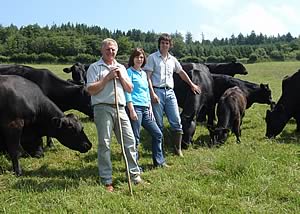2009-07-30
The Westwilmer herd owned by Malcolm and Sheridan Westcott and their son Dominic, who farm at Porlock, near Minehead, Somerset, has been recognised by EBLEX as the Most Improved Herd of Aberdeen Angus for 2008/09.
Malcolm, Sheridan and Dominic Westcott with the Westwilmer Aberdeen Angus Herd 2009
.
 |
The award is presented by the EBLEX Beef Better Returns Programme (Beef BRP), to the recorded herd that shows the greatest genetic gain for commercial traits over a 12-month period. There is a separate award for each of ten UK breeds.
Malcolm Westcott and his wife and son, farm over 900ha (2,200 acres) of land rented from The National Trust and The Crown Estate. Much is classed as common land or rough grazing, but there is 200ha (490 acres) of productive grassland and 14ha (35 acres) of cereals.
Fourteen hundred breeding ewes and followers run alongside 53 pedigree Aberdeen Angus cows and progeny. In August 2008 the farm started organic conversion.
The Westcott family has been farming at Wilmersham on Exmoor since 1938, originally with Red Devon cattle and Hereford and Devon cross cattle. They had been using an Angus bull for ease of calving on the heifers, and were pleased with the results. When two pedigree Aberdeen Angus herds were put up for dispersal in the West Country in 2006, they decided to start a pedigree Aberdeen Angus herd of their own.
Twenty-two cows were bought from the dispersals, and in July that year six further heifers were purchased from the Woodington herd and another three in-calf heifers and two cows with calves from the Wedderlie herd. Further pedigree heifers and cows were purchased in 2008 and 2009. From now on, the herd will be built up using home-bred replacements. In February 2007, two 21-month-old bulls were bought from Perth Bull Sales.
“One of the bulls, Blelack Best Mate is now producing calves with very good growth rates – which can be seen from their 200- and 400-day weights,” says Mr Westcott. “The other bull – Deeview Topgun, who was placed second in his class to the overall champion at the sale – is giving good eye muscle depth to his progeny.”
A third stock bull has recently been purchased from the Nightingale herd to provide a different bloodline for the heifers. All these bulls have performance records behind them.
The cows are split-calved in two batches – in the spring and autumn for ease of management and to fit in with lambing. The calves are weaned at seven to eight months of age, when the heifers and bulls are separated. They stay outside until mid-October, and are wintered indoors on silage with a little crimped barley and minerals.
To date all the heifers have been retained for replacements and the bulls sold to commercial producers – mainly dairy farmers looking particularly for bulls with good figures for calving ease.
The Westcotts started performance recording when their first Angus calves were born in spring 2007.
“We are still fairly new to using Estimated Breeding Values (EBVs), but it all seems to be going in the right direction. We chose the original bulls because they had good figures for growth, muscle depth and ease of calving, and last year’s calves are definitely more blocky and have greater length,” comments
Mr Westcott.
“Overall the herd is looking more uniform, and we can now start to pick out any surplus animals for culling this autumn.”
When asked how he felt about winning the award, Mr Westcott says: “It has really boosted our confidence, especially as the herd is so new. Overall the herd is looking more uniform and we are now achieving a good balance across the stock, in both type and breeding values. But without tools such as EBVs we could never have made so much progress so quickly.”
EBLEX breeding specialist Samuel Boon agrees.
“EBVs are measurements of genetic potential and provide a reliable insight into the effect a bull could have on the herd,” says Mr Boon. “It means producers can make informed purchasing decisions rather than leaving it to chance, and hoping the chosen bull will deliver on the commercially important traits.
“All the winners of the Improved Herd Awards record the performance of their herds. All are providing valuable information that can help customers produce animals that make them money because they meet processor/retailer and consumer demand, and do so as efficiently as possible. I congratulate the Westcotts on the excellent job they are doing with the Westwilmer herd.”
 Elmtree Herd Wins Most Improved Award for Limousin Breed Elmtree Herd Wins Most Improved Award for Limousin Breed
 Hackleton Aimee Supreme Blonde at Royal Welsh Show Hackleton Aimee Supreme Blonde at Royal Welsh Show
 Aberdeen-Angus Bull Sells in Five Figure Private Deal to Orkney Aberdeen-Angus Bull Sells in Five Figure Private Deal to Orkney

|




